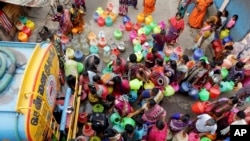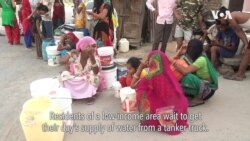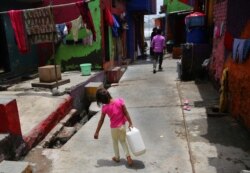As reservoirs in India’s sixth largest city, Chennai, almost went dry this week, affluent residents spent more money to buy the precious resource being ferried in by trucks from outside the city, poorer ones waited for hours in the scorching heat for erratic government supplies, some restaurants closed, and many offices curtailed working hours.
While the southern city faces chronic water shortages, the situation has reached a crisis point this summer. In Subhra Banerjee’s upmarket apartment complex, residents are using disposable plates, restricting baths and throwing wastewater in toilets to minimize consumption. But some days can be really bad. “We are sometimes totally out of stock. We are quite panicky,” he says.
The situation is not much better in sprawling low-income neighborhoods in the Indian capital. The day begins with a scramble for water, but it is not easy to get hold of a few buckets. As a tanker rolls in with the critical resource, many get elbowed and pushed in the mad rush to fill containers, tempers get frayed and some children even squeeze under the truck to salvage a few drops from leaking pipes.
“Those who can push, fill the water — others cannot,” says Ayesha Khatun, a resident of a slum in New Delhi. “For three days I am filling my container with whatever is spilled by others.”
Another relentless summer has dried up taps in large parts of urban India as reservoir levels run dangerously low. The situation is even bleaker across vast swathes of rural areas, where women walk miles to get water as it disappears from local bodies of water.
As lakes and rivers that have been harnessed to meet the needs of a growing population shrink, and ground water levels plummet due to over extraction by farmers, India is staring at a massive water crisis.
Six hundred million people, or roughly half the country, face high to extreme water shortages, a government report estimated last year. It warned that 21 major cities, including New Delhi, Chennai and Bengaluru, would soon run out of groundwater.
To address the grave problem, the newly elected government this month agreed to establish a Water Ministry with the ambitious goal of providing piped water to every household in five years.
“Only 18 percent have access to piped water, and that figure too may not reflect ground realities,” according to Gajendra Singh Shekawat, who heads the ministry.
But experts question how the government will ensure that water will flow in the pipes when vast regions in the country are running dry.
“In the coming years our deficit is going to be 43 percent between water availability and water requirement,” according to Shekawat.
As India gets down to addressing the mammoth challenge of bridging this shortfall, questions are being raised over how it should be done – through mega-multi-billion-dollar projects, or small community led initiatives that focus on water conservation.
The government says it is fast tracking an ambitious but controversial $ 87 billion-dollar project to link 60 rivers. The aim: to build dams and a network of canals that will divert water from rivers that routinely overflow during the monsoon season and flood vast tracts in the northeast to parched rivers in southern and western India.
It's proponents see it as a showpiece project that will end devastating floods and droughts.
But some conservationists like Rajendra Singh call the river-linking scheme “dangerous” because it will involve large-scale destruction of the habitat. “Lifting water to put in other rivers will cost too much. It will involve cutting trees, destroy the environment further and intensify disputes between states,” says the winner of the Magsaysay Award and Stockholm Water Prize, who has been nicknamed India’s “Waterman.”
Many like him are instead pushing for greater focus on conservation measures to capture rainfall – India’s main source of water that falls during three months of the monsoon season. Most of it runs off into storm water in drains in cities and evaporates or flows into the sea in rural areas.
Singh points to the transformation that was brought about in roughly 1,200 villages spread over a nearly 11,000-square-kilometer area in the parched desert state of Rajasthan. That is where local communities constructed hundreds of aquifers in vertical tracts so rainwater could be stored without evaporation. Over time, groundwater levels that had plummeted to 90 meters rose to between three and nine meters from the surface, and parched water bodies revived. Water shortages ended, reversing a migration into cities as people returned to villages to farm their land.
“We used engineering and science to store rainwater like a fixed deposit, which would recharge ground water and rivers,” he says. “Water must be treated like a bank account, you can only withdraw as much as you put in. At the moment most of the country is running an overdraft.”
It’s a call that many experts echo and say that such “iconic” efforts should be promoted across the country. They agree transporting water across thousands of miles from water surplus regions to drier ones is expensive and difficult.
Veena Srinivasan, at the Ashoka Trust for Research in Ecology and Environment, says one of the significant steps to plug shortages is to stop cultivation of thirsty crops like paddy in water- deficient areas. In the western Maharashtra state, for example, experts blame the switch from traditional crops to widespread cultivation of sugarcane for the parched countryside.
For decades, farmers have pumped ground water to irrigate crops without any regulation, resulting in a dangerous fall in groundwater levels in many parts of the country. "India has to learn to do more with less," says Srinivasan.
As India searches for solutions to its water crisis, millions only know one thing: the bleak situation is worsening their living conditions. “Our children fall sick with the contaminated water,” says Raju Devi in a low-income neighborhood in New Delhi as she fills four buckets from a water tanker. For the rest, she has to to “borrow and beg” from those who manage to corner more. “We never have enough to wash and clean.”







